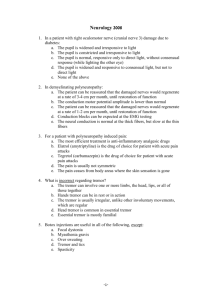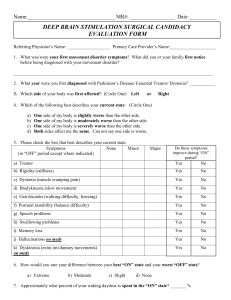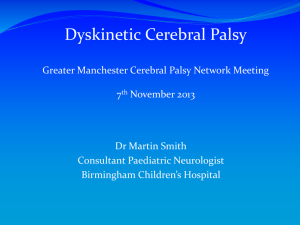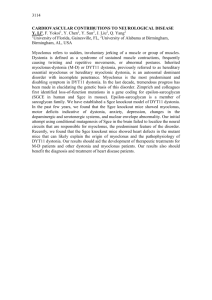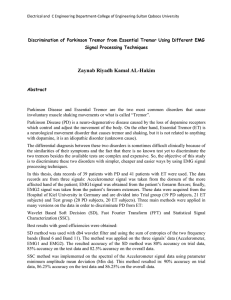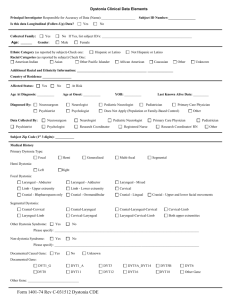The Phenotypic Spectrum of DYT24 Due to ANO3 Mutations
advertisement
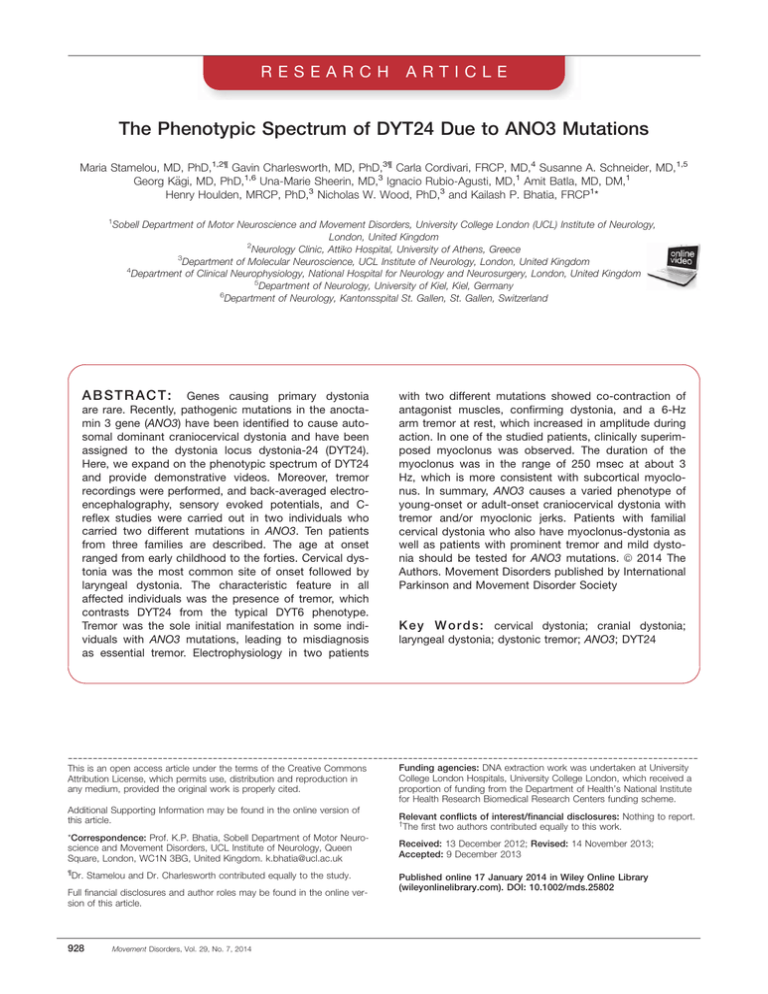
RESEARCH ARTICLE The Phenotypic Spectrum of DYT24 Due to ANO3 Mutations Maria Stamelou, MD, PhD,1,2¶ Gavin Charlesworth, MD, PhD,3¶ Carla Cordivari, FRCP, MD,4 Susanne A. Schneider, MD,1,5 €gi, MD, PhD,1,6 Una-Marie Sheerin, MD,3 Ignacio Rubio-Agusti, MD,1 Amit Batla, MD, DM,1 Georg Ka Henry Houlden, MRCP, PhD,3 Nicholas W. Wood, PhD,3 and Kailash P. Bhatia, FRCP1* 1 Sobell Department of Motor Neuroscience and Movement Disorders, University College London (UCL) Institute of Neurology, London, United Kingdom 2 Neurology Clinic, Attiko Hospital, University of Athens, Greece 3 Department of Molecular Neuroscience, UCL Institute of Neurology, London, United Kingdom 4 Department of Clinical Neurophysiology, National Hospital for Neurology and Neurosurgery, London, United Kingdom 5 Department of Neurology, University of Kiel, Kiel, Germany 6 Department of Neurology, Kantonsspital St. Gallen, St. Gallen, Switzerland ABSTRACT: Genes causing primary dystonia are rare. Recently, pathogenic mutations in the anoctamin 3 gene (ANO3) have been identified to cause autosomal dominant craniocervical dystonia and have been assigned to the dystonia locus dystonia-24 (DYT24). Here, we expand on the phenotypic spectrum of DYT24 and provide demonstrative videos. Moreover, tremor recordings were performed, and back-averaged electroencephalography, sensory evoked potentials, and Creflex studies were carried out in two individuals who carried two different mutations in ANO3. Ten patients from three families are described. The age at onset ranged from early childhood to the forties. Cervical dystonia was the most common site of onset followed by laryngeal dystonia. The characteristic feature in all affected individuals was the presence of tremor, which contrasts DYT24 from the typical DYT6 phenotype. Tremor was the sole initial manifestation in some individuals with ANO3 mutations, leading to misdiagnosis as essential tremor. Electrophysiology in two patients with two different mutations showed co-contraction of antagonist muscles, confirming dystonia, and a 6-Hz arm tremor at rest, which increased in amplitude during action. In one of the studied patients, clinically superimposed myoclonus was observed. The duration of the myoclonus was in the range of 250 msec at about 3 Hz, which is more consistent with subcortical myoclonus. In summary, ANO3 causes a varied phenotype of young-onset or adult-onset craniocervical dystonia with tremor and/or myoclonic jerks. Patients with familial cervical dystonia who also have myoclonus-dystonia as well as patients with prominent tremor and mild dystoC 2014 The nia should be tested for ANO3 mutations. V Authors. Movement Disorders published by International Parkinson and Movement Disorder Society K e y W o r d s : cervical dystonia; cranial dystonia; laryngeal dystonia; dystonic tremor; ANO3; DYT24 -----------------------------------------------------------------------------------------------------------------------------This is an open access article under the terms of the Creative Commons Attribution License, which permits use, distribution and reproduction in any medium, provided the original work is properly cited. Additional Supporting Information may be found in the online version of this article. *Correspondence: Prof. K.P. Bhatia, Sobell Department of Motor Neuroscience and Movement Disorders, UCL Institute of Neurology, Queen Square, London, WC1N 3BG, United Kingdom. k.bhatia@ucl.ac.uk ¶ Dr. Stamelou and Dr. Charlesworth contributed equally to the study. Full financial disclosures and author roles may be found in the online version of this article. 928 Movement Disorders, Vol. 29, No. 7, 2014 Funding agencies: DNA extraction work was undertaken at University College London Hospitals, University College London, which received a proportion of funding from the Department of Health’s National Institute for Health Research Biomedical Research Centers funding scheme. Relevant conflicts of interest/financial disclosures: Nothing to report. † The first two authors contributed equally to this work. Received: 13 December 2012; Revised: 14 November 2013; Accepted: 9 December 2013 Published online 17 January 2014 in Wiley Online Library (wileyonlinelibrary.com). DOI: 10.1002/mds.25802 T H E Recently, using whole-exome sequencing and linkage analysis, pathogenic mutations of the ANO3 gene (encoding for anoctamin 3) were identified as a new cause of primary familial craniocervical dystonia in an autosomal dominant kindred.1 ANO3 (Mendelian Inheritance in Man number, 610110; National Center for Biotechnology GeneBank Reference Sequence number, NM_031418) is located on chromosome 11, consists of 27 exons, and is highly expressed in the striatum.1 By homology with other members of this gene family, anoctamin 3 is a probable Ca21-gated chloride channel, and functional studies using Ca21 imaging in mutation-bearing and control fibroblasts demonstrated clear abnormalities in endoplasmic reticulum-dependent Ca21 signalling.1 Here, we describe and illustrate with videos the phenotypic spectrum of DYT24 due to ANO3 mutations in the identified familial cases. We discuss the clinical implications and compare these cases with the phenotypes of dystonia-1 (DYT1); DYT6; guanine nucleotide binding protein (G protein) alpha activating polypeptide, olfactory type (GNAL); and DYT11 dystonia. Patients and Methods Standard Protocol Approvals, Registrations, and Patient Consents The study was approved by the University College London Hospitals/University College London ethics committee (University College London Hospitals project ID number 06/N076), and informed consent was given by all family members. Patients In total, 384 patients with sporadic (n 5 247) and familial (n 5 137) craniocervical dystonia were screened for mutations in exon 15 of the ANO3 gene.1 Of these, 112 patients (approximately 29%) had tremulous dystonia, and approximately 71% had nontremulous dystonia. One hundred seventy-five of 384 patients (45.5%) had adult-onset dystonia (at age >25 years), and 54.5% had young-onset dystonia. Forty of 384 patients had generalized dystonia. One hundred ninety of 384 patients were screened for mutations in all 27 exons of ANO3. Three families (10 individuals) were identified that harbored novel, putatively pathogenic mutations in ANO3. The description of these patients is provided below (see Results) and the family pedigrees are given in Fig. 1A,1B and 1C. Electrophysiology Apart from dystonia, all patients also had tremor. Therefore, we obtained electromyography (EMG) recordings to characterize the tremor in two patients P H E N O T Y P I C S P E C T R U M O F D Y T 2 4 who had different mutations in ANO3. Moreover, superimposed myoclonus was noted in two patients. In one of these, we performed specialized electrophysiology to characterize the nature of the myoclonus, as outlined below. EMG and Back-Averaged Electroencephalography Surface EMG was recorded from the involved muscles, which were chosen based on clinical observation of the most affected body parts using bipolar silver/ silver chloride electrodes placed 2 cm apart over the belly of the muscles. Electroencephalography (EEG) was recorded from electrodes positioned on the frontocentral areas (International 10-20 system) with midline frontal (Fz) as the reference. Recordings were obtained at rest, with arms outstretched, and during action. One of the muscles most regularly involved in each jerk was selected to trigger the collection of EEG data for backaveraging. Only muscles with a well-defined burst of activity in each jerk were chosen. The video EEG-EMG recording was performed for about 60 minutes. Bilateral frontocentral regions (F4-C4, C4-Cz, F3-C3, C3Cz) and cranial and limb muscles (orbicularis oculi, left sternocleidomastoid [SCM], right levator scapulae [LS], deltoid, biceps, extensor carpi radialis [ECR], flexor carpi radialis [FCR], first dorsal in-terosseus [1DIO], and rectus abdominis) were simultaneously recorded. Median Nerve Somatosensory Evoked Potential and C Reflex The median nerve was stimulated at the left wrist with square wave pulses of 200-msec pulse width at just above the motor threshold at 2 Hz. Silver-silver chloride recording electrodes were placed on C30 (2 cm behind C3), C40 (2 cm behind C4) contralateral to the side of stimulation, and Fz (midline frontal). The filter band pass was 0.5 Hz to 1 kHz, and 1,000 sweeps were averaged. The amplitudes of the N20, P25, and N35 peaks were determined from the C30-Fz or C40-Fz recordings. The long loop reflex (C reflex) was simultaneously recorded on the thenar muscles from the median nerve stimulation at the wrist. Results Routine magnetic resonance imaging studies and basic investigations for secondary/heredodegenerative dystonias were carried out in at least one affected member of each family and were normal. Genetic tests for DYT1, DYT6, and DYT11 (including large deletions) using standard published methods2 were performed and were negative. None of the patients were previously exposed to neuroleptic drugs. Movement Disorders, Vol. 29, No. 7, 2014 929 S T A M E L O U E T A L FIG. 1. The family pedigrees are shown for (A) Family 1, (B) Family 2, and (C) Family 3. Family 1 Family 1 is the index family in which the gene was identified.1,3 Clinical details of this family have been published elsewhere (Fig. 1A; Video Segment 1). Age at onset ranged from 19 to 40 years (Table 1). The affected members of this family have a missense mutation in exon 15 (c.1480A>T; p.R494W) of the ANO3 gene that is segregated in the affected family members and absent in unaffected family members.1 Patient II-4 (Table 1, Video Segment 1A), with intermittent blepharospasm and torticollis to the left, had electrophysiology of neck and limb muscles that showed continuous muscle over-activity in the levator scapulae, ECR, and FCR. There was a mild limb cocontraction tremor of the neck and the arms with the hand supported in semisupination, against gravity and during action, at about 6 Hz. There were no interruptions of muscle activity when holding both arms against gravity. Auditory stimulation (tapping stimulation of the mantle area) did not produce any abnormal startle response. EEG back-averaging was not possible because of the dystonic pattern underlying the muscle bursts. Family 2 Patient III-1 (age 65 years) (Fig. 1B) first noticed an intermittent head tremor at the age of 4 years and recalls being teased for this at school. Gradually, the head tremor became constant and was exaggerated by stress, while alcohol did not produce any improve- 930 Movement Disorders, Vol. 29, No. 7, 2014 ment. In his teens, his voice became tremulous; and, by adulthood, his writing had become shaky. On examination at age 53 years, he had a side-to-side head tremor and oromandibular movements. He had voice tremor and a mild, fine postural tremor more on the right arm. The head tremor responded well to botulinum toxin injections. Examination at age 65 years showed no further progression of his symptoms. His daughter, patient IV-1 (age 39 years), developed laryngeal dysphonia at the age of 5 years and, shortly thereafter, difficulties with her jaw. At age 14 years, she developed tremor of her head and arms. Alcohol had no influence on the tremor. On examination at age 39 years, she had a torticollis to the left and head tremor. She had occasional finger and arm tremor on arms outstretched and occasional superimposed myoclonic jerks. She had laryngeal dysphonia and mild oromandibular dystonia (Video Segment 2A). Electrophysiology on this patient showed intermittent blepharospasm (Fig. 2) and torticollis to the right. There was underlying, continuous muscle overactivity in the levator scapulae, ECR, and FCR. There was tremor of the neck, trunk, and limbs. There was a mild limb co-contraction tremor with the hand supported in semisupination, against gravity and during action, at about 6 Hz. The myoclonic jerks of the neck were mostly torticollic rather than retrocollic. The duration of myoclonus was about 250 msec with a variable frequency of 3 to 4 Hz at rest. There were no interruptions of muscle activity T H E P H E N O T Y P I C S P E C T R U M O F D Y T 2 4 TABLE 1. The clinical features and evolution of the 10 affected members from 3 families Individual (sex/age, y) Age of Onset. y Follow-Up, y Site of Onset Cervical Dystonia Family 1 I-1 (F/deceased) 27 — Cervical Torticollis II-1 (M/age 67) 40 27 Cervical Torticollis to the right II-4 (M/69) 30 39 Laryngeal Torticollis II-7 (W/deceased) 30 27 Cervical Torticollis III-7 (W/36) 19 17 Cervical Family 2 III-1 (M/65) 3-4 61 IV-1 (F/39) 4-5 IV-2 (M/37) Upper Limb Dystonia Cranial Dystonia Laryngeal dysphonia, adductor dysphonia Blepharospasm, adductor dysphonia — Blepharospasm, adductor dysphonia, oromandibular Adductor dysphonia Mild Torticollis Adductor dysphonia Mild Cervical Torticollis Laryngeal, oromandibular, blepharospasm — 30 Laryngeal Torticollis Mild fingers bilateral 30 7 Right arm - Laryngeal, oromandibular, blepharospasm - Family 3 II-1 (F/31) 6 25 Cervical Torticollis Laryngeal Mild III-1 (M/9) 6 3 Left arm No No - Tremor Myoclonus Head, mild bilateral postural arms Head, mild bilateral postural asymmetric arms Head; mild on the left arm — — Head, bilateral postural asymmetric arms Head Mild fingers only on the right Head, mild bilateral postural asymmetric arms Finger tremor and asymmetric arm tremor Mild postural tremor, more on the right arm Mild, postural and action, asymmetric arms; head Moderate, mainly on action, asymmetric arms Torticollis and retrocollic myoclonic jerks Proximal and distal myoclonic jerks (arms) F, female; M, male. when holding both arms against gravity. Auditory stimulation (tapping stimulation of the mantle area) did not produce any abnormal startle response. EEG back-averaging was not possible because of the dystonic pattern underlying the muscle bursts, which nonetheless were of long duration (250 msec). An investigation of somatosensory evoked potentials did not indicate any giant evoked potentials (P25-N35, 4 lV; N20-P25, 6.6. lV). Patient IV-2 is 37-year old man who developed a bilateral (more on the right) postural hand tremor at the age of 30 years. On examination at age 37, he had a mild voice tremor, fine postural arm tremor more on the right, and a mild dystonic posturing of the fingers on the right (Video Segment 2B). The affected members of this family carry a heterozygous missense mutation (c.1470G>C; p.W490C) in the ANO3 gene.1 Interestingly, the grandmother of patient III-1, but not the mother, reportedly had head tremor. Although both individuals are now deceased and could not be examined, this suggests the possibility of reduced penetrance. Family 3 Patient II-1 (Fig. 1C) is a 31-year old woman who developed tremor of her head and intermittent tremor of her hands, mostly when under stress, at age 6 years. At age 19 years, she noticed problems with her voice. At age 20 years, she was diagnosed with essential tremor (ET). She was started on propranolol with no improvement and, later, received clonazepam, which had no effect. On examination (at age 31 years), she had a nono head tremor, which was exaggerated with action and under stress. She had adductor laryngeal dysphonia (Video Segment 3A). She had a mild postural and action Movement Disorders, Vol. 29, No. 7, 2014 931 S T A M E L O U E T A L FIG. 2. The dystonic activity of patient IV-1 (Family 2) is illustrated. There is intermittent activity in the orbicularis occuli muscles clinically presenting with blepharospasm. There is tremoulous torticollis to the right with continuous activity in the left sternocleidomastoid (LSCM) and the right levator scapulae (RLevSc) muscle. There is dystonic tremor at 6 Hz, superimposed myoclonic jerks at 3 to 4 Hz, and duration no shorter than 250 msec. There was underlying, continuous muscle over-activity in the extensor carpi radialis (ECR) and the flexor carpi radialis (FCR) [Color figure can be viewed in the online issue, which is available at wileyonlinelibrary.com.]. tremor more on the right arm, which would appear only in particular situations. The remainder of the clinical examination was unremarkable. Her 9-year old son (patient III-1) noticed a tremor of his hands more on the left, at age 6 years. On examination at age 9 years, he had proximal and distal myoclonus in his outstretched arms and tremor, more on the left and mainly when performing motor tasks (Video Segment 3B). The rest of the examination was normal. Interestingly, the 65-year old grandmother (patient I2) developed head and arm tremor at age 7 years, with no affection of her voice, and was diagnosed with ET. The younger sister (patient II-4; age 30 years) is said to have a voice tremor. However, both the grandmother and the younger sister reside outside the United Kingdom and were not available for examination. Of interest, patient II-1, who underwent surgery for an ArnoldChiari malformation and has a son with autism (who was not affected by dystonia and was not tested for ANO3 mutations), had a previous termination of pregnancy due to anencephaly of the fetus and has a nephew from her affected sister with agenesis of the 932 Movement Disorders, Vol. 29, No. 7, 2014 corpus callosum (who was not tested for ANO3 mutations). It is unknown whether these developmental malformations could represent associated features of ANO3 dysfunction or are purely coincidental. The affected members of this family carry a mutation in exon 21 of ANO3 (c.2053A>G, p.S685G). Discussion Here, we expand on the phenotypic manifestations of DYT24 caused by mutations in the newly identified dystonia gene ANO3. These comprise a spectrum, from a variable combination of cervical dystonia with tremor (Family 1 and Family 2 [patients III-1, IV-1], Family 3 [patient II-1]), cranial dystonia (blepharospasm, oromandibular dystonia) and laryngeal dystonia (Family 1, Family 2, and Family 3 [patient II-1]) to initially isolated and later predominant arm tremor with only minimal dystonic posturing of the fingers (Family 2 [patient IV-2], Family 3 [patient III-1]) and myoclonus of subcortical origin (Family 2 [patient IV- T H E 1], Family 3[patient III-1]). The range of age at onset varies from early childhood to the forties, implying that this gene may play a role in both young-onset and adult-onset dystonia. The cervical region was the most common site of onset, followed by laryngeal dystonia, and then the arms; whereas the legs were never affected. In most patients, dystonia progressed slowly over many years and spread to become segmental. Importantly, however, none of the patients developed generalized dystonia regardless age of onset and despite the long follow-up period. Among the genetic primary dystonias, craniocervical dystonia has been mainly described in the context of DYT6 caused by THAP1 (thanatos-associated protein 1) gene mutations. The mean age at onset in DYT6 is 24.4 years (range, 2-62 years),4 and the most common site of onset is the upper limb (47%) followed by cranial dystonia (25%), cervical dystonia (23%), and rarely leg dystonia (17%).4,5 In more than half of DYT6 patients, dystonia spreads to become generalized or multifocal, which contrasts our DYT24 patients.2,4-8 Recently, mutations in GNAL have also been identified to cause craniocervical dystonia.9 The average age of dystonia onset in those patients was 31.3 years (range, 7-54 years). Most carriers (82%) had onset in the neck, and most progressed to have dystonia at other sites. Cranial involvement was present in 57% of carriers, while brachial onset was not observed, and eventual arm involvement was seen in only 32% of carriers, in contrast to THAP1 mutation carriers.9 Probably the most consistent feature in our patients with DYT24 was the presence of tremor. This cannot be screening bias, because an equal distribution of patients with and without tremor was screened. Interestingly, from 273 consecutive cervical dystonia patients, cervical dystonia with tremor was quite frequent (46%), and these patients more frequently reported a positive family history of dystonia or tremor (50%) than those without tremor (18%) in one study.10 Tremor as the predominant feature has been described only rarely in DYT6.4-7,11-16 Tremor has been described in DYT1, but the typical distribution, with dystonia starting in a lower limb and usually generalizing over some years, is quite distinct from the clinical picture in these ANO3 patients.17 Also, in the patients with GNAL mutations, tremors have not been reported; however, further carriers are needed to reach a conclusion regarding the occurrence of tremor in these patients.9 Therefore, tremor may represent one of the major phenotypic differences between DYT6 and DYT24 craniocervical dystonia and a clue to test for ANO3 mutations. Two patients in our study, apart from tremor, had superimposed myoclonic jerks, and indeed myoclonusdystonia (M-D) was considered as a possibility, although they tested negative for DYT11 (e-sarcoglycan P H E N O T Y P I C S P E C T R U M O F D Y T 2 4 mutations). It is estimated that DYT11 accounts for about 30% of familial M-D cases, implying that further genes may cause an M-D phenotype.18 It is possible that ANO3 mutations could account for at least some of those cases. DYT11 M-D presents with young-onset, action-induced, alcohol-responsive, brief, lightning myoclonic jerks that predominantly affect the cervical region (mainly retrocollic) and the upper limbs and less frequently affect the legs, while dystonic posturing may be present.18-23 In our patients, no such brief, shock-like myoclonic jerks were noted clinically or in electrophysiology. Thus, a case could be made for testing DYT11negative patients with M-D for ANO3 mutations. Some of the patients with ANO3 mutations were affected by tremor as the sole initial manifestation without or (later) with very mild dystonic posturing that was misdiagnosed as ET. These patients are important: first, they highlight the caveats in the current classification of dystonic tremor that requires the presence of clear dystonic posturing for diagnosis, which, if mild, can be missed on examination and may lead to misdiagnosis.24 Second, patients with genetically defined dystonia and prominent tremor are excellent candidates for electrophysiological studies to define laboratory criteria for the diagnosis of this tremor. Moreover, because patients with primary young-onset or adult-onset dystonia might present with an asymmetric arm and head and voice tremor without clear dystonic posturing, they could be misdiagnosed with ET, as in Family 3. The observations in our patients support the suggestion that patients who have isolated head tremor and head or voice tremor before the appearance of (or more severe than) hand tremor should be cautiously examined for even mild signs of dystonia (such as only mild dystonic finger posturing) before they are diagnosed with ET.8 The identification of the ANO3 gene needs to be confirmed from independent studies, which also would allow an estimation of its frequency compared with other dystonia genes. Moreover, additional families are needed to unravel the full phenotypic spectrum of DYT24. Although the pathophysiology is not clear, the function of this gene is fascinating, because, for the first time, it implicates ion-channel dysfunction as a pathophysiological mechanism in dystonia. Legends to the Videos Video 1. Family 1: Segment 1A shows patient II-4 at the age of 69 years (his symptoms having worsened from the earlier report at age 55 years)3, with torticollis to the left and tremor, blepharospasm, oromandibular movements, laryngeal dystonia, and a mild tremor on the left arm only with action. Segment 1B shows patient III-7 at the age of 36 years with tremulous torticollis to the right, laryngeal dystonia, and no Movement Disorders, Vol. 29, No. 7, 2014 933 S T A M E L O U E T A L arm tremor but a mild dystonic posturing of the arms in certain positions (the patient at age 24 years had milder symptoms and no laryngeal involvement).3 Video 2. Family 2: Segment 2A shows patient IV-1 with oromandibular movements, laryngeal dysphonia, head tremor, torticollis to the right, torticollic and retrocollic myoclonic jerks, and finger and arm myoclonus more on the left. Segment 2B shows patient IV-2 with mild dystonic finger posturing and mild postural tremor on the right hand. Video 3. Family 3: Segment 3A shows patient II-1 with head tremor, mild torticollis to the right, and laryngeal dystonia. Segment 3B shows patient III-1 with arm tremor more on the left, which increases on action, and occasional myoclonic jerks on both arms. Acknowledgments: We thank the patients for their consent to 8. Quinn NP, Schneider SA, Schwingenschuh P, Bhatia KP. Tremor— some controversial aspects. Mov Disord 2011;26:18-23. 9. Fuchs T, Saunders-Pullman R, Masuho I, et al. Mutations in GNAL cause primary torsion dystonia. Nat Genet 2013;45:88-92. 10. Rubio-Agusti I, Parees I, Kojovic M, Stamelou M, Saifee TA, Charlesworth G, Sheerin UM, Edwards MJ, Bhatia KP. Tremulous cervical dystonia is likely to be familial: clinical characteristics of a large cohort. Parkinsonism Relat Disord. 2013;19(6):634-638. 11. Almasy L, Bressman SB, Raymond D, et al. Idiopathic torsion dystonia linked to chromosome 8 in two Mennonite families. Ann Neurol 1997;42:670-673. 12. Fuchs T, Gavarini S, Saunders-Pullman R, et al. Mutations in the THAP1 gene are responsible for DYT6 primary torsion dystonia. Nat Genet 2009;41:286-288. 13. Djarmati A, Schneider SA, Lohmann K, et al. Mutations in THAP1 (DYT6) and generalised dystonia with prominent spasmodic dysphonia: a genetic screening study. Lancet Neurol 2009;8: 447-452. 14. Bonetti M, Barzaghi C, Brancati F, et al. Mutation screening of the DYT6/THAP1 gene in Italy. Mov Disord 2009;24:2424-2427. 15. Groen JL, Ritz K, Contarino MF, et al. DYT6 dystonia: mutation screening, phenotype, and response to deep brain stimulation. Mov Disord 2010;25:2420-2427. 16. Cheng FB, Ozelius LJ, Wan XH, et al. THAP1/DYT6 sequence variants in non-DYT1 early-onset primary dystonia in China and their effects on RNA expression. J Neurol 2012;259:342-347. publish the video. References 1. Charlesworth G, Plagnol V, Holmstrom KM, et al. Mutations in ANO3 cause cranio-cervical dystonia: a novel molecular mechanism. Am J Hum Genet 2012;91:1040-1050. 17. Stamelou M, Edwards MJ, Bhatia KP. Late onset rest-tremor in DYT1 dystonia. Parkinsonism Relat Disord 2012;19:136-137. 2. Houlden H, Schneider SA, Paudel R, et al. THAP1 mutations (DYT6) are an additional cause of early-onset dystonia. Neurology 2010;74:846-850. 18. Spatola M, Wider C. Overview of primary monogenic dystonia. Parkinsonism Relat Disord 2012;18(suppl 1):S158-S161. 19. 3. Munchau A, Valente EM, Davis MB, et al. A Yorkshire family with adult-onset cranio-cervical primary torsion dystonia. Mov Disord 2000;15:954-959. Zimprich A, Grabowski M, Asmus F, et al. Mutations in the gene encoding epsilon-sarcoglycan cause myoclonus-dystonia syndrome. Nat Genet 2001;29:66-69. 20. 4. Blanchard A, Ea V, Roubertie A, et al. DYT6 dystonia: review of the literature and creation of the UMD Locus-Specific Database (LSDB) for mutations in the THAP1 gene. Hum Mutat 2011;32: 1213-1224. Asmus F, Devlin A, Munz M, Zimprich A, Gasser T, Chinnery PF. Clinical differentiation of genetically proven benign hereditary chorea and myoclonus-dystonia. Mov Disord 2007;22:2104-2109. 21. 5. Xiromerisiou G, Houlden H, Scarmeas N, et al. THAP1 mutations and dystonia phenotypes: genotype phenotype correlations. Mov Disord 2012;27:1290-1294. Wong SH, Steiger MJ, Larner AJ, Fletcher NA. Hereditary myoclonus dystonia (DYT11): a novel SGCE gene mutation with intrafamilial phenotypic heterogeneity. Mov Disord 2010;25:956-957. 22. 6. Bressman SB, Raymond D, Fuchs T, Heiman GA, Ozelius LJ, Saunders-Pullman R. Mutations in THAP1 (DYT6) in early-onset dystonia: a genetic screening study. Lancet Neurol 2009;8:441446. Roze E, Apartis E, Trocello JM. Cortical excitability in DYT-11 positive myoclonus dystonia. Mov Disord 2008;23(5):761-764. 23. Marelli C, Canafoglia L, Zibordi F, et al. A neurophysiological study of myoclonus in patients with DYT11 myoclonus-dystonia syndrome. Mov Disord 2008;23:2041-2048. 7. Clot F, Grabli D, Burbaud P, et al. Screening of the THAP1 gene in patients with early-onset dystonia: myoclonic jerks are part of the dystonia 6 phenotype. Neurogenetics 2011;12:87-89. 24. Deuschl G, Bain P, Brin M. Consensus statement of the Movement Disorder Society on Tremor. Ad Hoc Scientific Committee. Mov Disord 1998;13(suppl 3):2-23. 934 Movement Disorders, Vol. 29, No. 7, 2014
